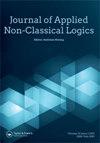Temporal logic of surjective bounded morphisms between finite linear processes
Q1 Arts and Humanities
引用次数: 0
Abstract
In this paper we study a temporal logic for finite linear structures and a surjective bounded morphism between them. We give a modal axiomatization of such structures and also show that any such structure can be uniquely characterised by a temporal formula, up to an isomorphism. As a main theorem we prove Kripke completeness of the proposed axiomatization. Finite linear structures, i.e., finite sets with a strict linear ordering, naturally arise as representations of a discrete, bounded time flow. Many domains of our everyday practice including time series [2], linear planning [4], [7], scene analysis [1], [9], chain-of-responsibility design pattern in programming [3], [8], etc. involve a finite linear structure to represent a sequence of consecutive steps. In many such scenarios, the processes (F,<) comes with a natural partition ⋃ i∈I Fi of F into convex equivalence classes Fi. We call Fi convex if for each a, b ∈ Fi with a < b and each t with a < t < b, we have t ∈ Fi. In such a case, the index set I naturally “inherits” a linear ordering from (F,<). Mathematically, such a process ( ⋃ i∈I Fi, <) can be represented as two temporal linear structures F and I related by means of a bounded morphism. An example of such a structure comes from the analysis of video data where the linear sequence of image frames is partitioned into intervals (grouped in some way e.g. by homogeneous sound moments, or by each interval representing an episode, or a scene). In the area of computer vision, deep learning (DL) methods usually process a video stream as a black box, without looking into the temporal structure or content [6]. By contrast, we aim to represent a high-level knowledge about frames, scenes and their temporal interrelationships and to develop formal languages capable of reasoning about resulting structures [5]. To flesh out this approach a little more, let us consider a conceptual representation of a movie. The raw video data of the movie can simply be represented as a sequence of frames. On a slightly higher level of conceptualization, the same raw data can be understood as a sequence of scenes, where a scene is a subset of logically related consecutive frames. If one also “remembers” which frame belongs to which scene, the following structure emerges:有限线性过程间满射有界态射的时间逻辑
摘要本文研究了有限线性结构及其间满射有界态射的时间逻辑。我们用模态公式给出了这类结构的特征,并证明了它们之间具有有界态射的每一对线性结构都可以用一个直到同构的时间公式唯一地表征。作为主要结果,我们证明了关于一类具有有界态射的有限线性结构的逻辑的Kripke完备性。关键词:时间逻辑模态可定义性kripke完备性感谢匿名审稿人和George Nadareishvili博士的宝贵意见。披露声明作者未报告潜在的利益冲突。从现在起,“一帧”指的是“克里普克帧”,而不是“电影帧”。第一、第二和第四作者得到了乔治亚州Shota Rustaveli国家科学基金会(SRNSFG)的部分资助[资助号#FR-22-6700]。第三位和第五位作者得到了Crafoord项目的部分资助[资助号#20200953]。
本文章由计算机程序翻译,如有差异,请以英文原文为准。
求助全文
约1分钟内获得全文
求助全文
来源期刊

Journal of Applied Non-Classical Logics
Arts and Humanities-Philosophy
CiteScore
1.30
自引率
0.00%
发文量
8
 求助内容:
求助内容: 应助结果提醒方式:
应助结果提醒方式:


